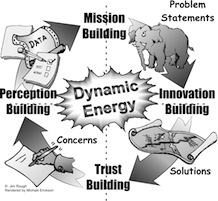Choice-creating is the quality of being and thinking that often happens after a crisis, when people drop their roles, express their true feelings, and join with others to creatively seek what’s best for all. “Choice-creating” is a heartfelt, creative quality of thinking where non-linear “shifts” and breakthroughs are natural. It is energy-based, where the “real” issues are identified and solved. In this state, unanimous conclusions are a natural result, while individual uniqueness and differences are celebrated and necessary. When facing “impossible to solve” problems, for building trust, or for transforming organizations, choice-creating is the desired quality of thinking.
How do we recognize Choice-creating? In a meeting, choice-creating is happening when people are addressing an issue people care about and each person is:
- Authentic… there are no roles or hidden agendas
- Open-minded… interested in different ideas
- Open-hearted… feelings and emotions are part of the process
- Learning… each person gains in capability
- Engaged… everyone is involved and wants to be part
- Efficient… conclusions are reached with less time and effort
- Creative… breakthroughs and shifts are frequent
- Respectful… each person is appreciated
In choice-creating …
- Results are win/win – better than anyone thought possible.
- Each person feels brilliant and involved, knows what to do, and is committed to helping.
- Individual capabilities, enthusiasm, and empowerment are raised.
- The group builds trust, the spirit of community, a feeling of “We.”

A Dynamic Facilitator assures Choice-creating...
The dynamic facilitator orients to choice-creating. S/he does this by following group energy more than using extrinsic factors like agendas, guidelines, or objectives to manage the process. S/he uses four charts – Solutions, Problem Statements, Concerns, and Data – to help people be fully heard. No one is judged, each comment is valued, and the group starts thinking creatively together. Being fully heard and orienting toward choice-creating brings out people’s natural ability to seek shared outcomes that will take everyone’s views into account.
